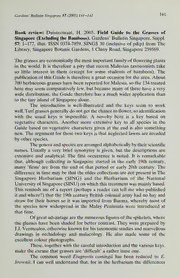
Book review: Duistermaat, H. 2005. Field Guide to the Grasses of Singapore (Excluding the Bamboos). Gardens' Bulletin Singapore, Suppl. 57: 1-177, illus. ISSN 0374-7859, SING$ 30 (inclusive of p&p) from The Library, Singapore Botanic Gardens, 1 Cluny Road PDF
Preview Book review: Duistermaat, H. 2005. Field Guide to the Grasses of Singapore (Excluding the Bamboos). Gardens' Bulletin Singapore, Suppl. 57: 1-177, illus. ISSN 0374-7859, SING$ 30 (inclusive of p&p) from The Library, Singapore Botanic Gardens, 1 Cluny Road
Gardens'Bulletin Singapore57(2005) 141-142 141 Book review: Duistermaat, H. 2005. Field Guide to the Grasses of Singapore (Excluding the Bamboos). Gardens' Bulletin Singapore, Suppl. 57: 1-177, illus. ISSN 0374-7859, SING$ 30 (inclusive of p&p) from The Library, Singapore Botanic Gardens, 1 Cluny Road, Singapore 259569. The grasses are economically the most important family offlowering plants in the world. It is therefore a pity that recent Malesian taxonomists take so little interest in them (except for some students of bamboos). The publication of this Guide is therefore a great occasion for the area. About 700 herbaceous grasses have been reported for Malesia, so the 134 treated here may seem comparatively few, but because many of these have a very wide distribution, the Guide therefore has a much wider application than to the tiny island of Singapore alone. The introduction is well-illustrated and the keys seem to work well. Turfgrasses generally do not get the chance to flower, so identification A with the usual keys is impossible. novelty here is a key based on vegetative characters. Another more extensive key to all species in the Guide based on vegetative characters given at the end is also something new. The argument for these two keys is that neglected lawns are invaded by other species. The genera and species are arranged alphabetically by their scientific names. Usually a very brief synonymy is given, but the descriptions are extensive and analytical. The first occurrence is noted. It is remarkable that, although collecting in Singapore started in the early 19th century, many 'firsts' are from the end of that period or early 20th century. The difference in time may be that the older collections are not present in The Singapore Herbarium (SING) and the Herbarium of the National University of Singapore (SINU) on which this treatment was mainly based. This reminds me of a report (perhaps a reader can tell me who published it and where?) that the 19th century British colonial army had no hay and straw for their horses so it was imported from Burma, whereby most of the species now widespread in the Malay Peninsula were introduced at that time. Ofgreat advantage are the numerous figures ofthe spikelets, where the glumes have been shaded for better contrast. They were prepared by J.J. Vermeulen, otherwise known for his taxonomic studies and marvellous drawings in orchidology and malacology. He also made some of the excellent colour photographs. These, together with the careful introduction and the various keys, make the excuse that grasses are 'difficult' a rather lame one. The common weed Eragrostis cumingii has been reduced to E. brownii. I can well understand that, for in the herbarium the differences 142 Card. BullSingapore57(2005) are slight and cumbersome: mainly in the basal branching system, which often is lacking, size of the anthers, and the colour of the caryopsis. Apparently in the field there are no supporting habitual characters. Current studies indicate that the correct name for what I and others previously have called E. amabilis is E. tenella after all (Veldkamp, unpublished). Figures 60 and 63 of E. atrovirens and E. gangetica are misleading, as only one or no glumes at all are depicted. In Figure 66 the fine sculpture of the lemmas of E. unioloides should have been accentuated whereby the species is immediately distinct from all others and especially from E. montana (which, as is shown, subtly differs by the shape of the glumes and lemmas, too, for the cognoscendi). There is a challenge to experimenters with the diaspores of Mnesithea glandulosa and Rottboellia cochinchinensis: the joints of the fragile racemes have a knob at the base, which is an elaiosome and attracts ants: do they carry them off? Contrary to the remark here (p. 90), Beumee [Handl. 4e Congr. Ned.-Indie Nat. Wet. (1927) 419] already reported it for both. Other ant plants may be the bottle-brush species of Setaria. Harvester ants (Camponotus spp.) cut up the inflorescences and take the spikelets to their lairs as I observed with S. italica here in Europe. Collect both ants and grass! It might be noted that Panicum maximum, according to recent studies, is actually a Urochloa with the first record for Singapore by Hullett, 27 Jan 1894. J.F. Veldkamp National Herbarium of the Netherlands University of Leiden Branch The Netherlands
